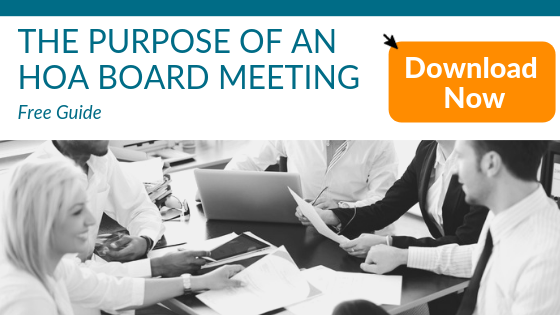Community board meetings can be challenging in terms of overcoming logistics. As always, the key is time invested in preparation and organization.
Please consider the “professional meeting skills tips” provided below that might assist your community in conducting a successful open meeting.
1. Set Up the Room
Seat all your board members at a head table. The table should be arranged in a semicircle with the president at the center. Place the board members on either side of the president. Have name cards printed large enough to be read by the community members present.
Seat the community association manager and other staff on one end of the table. Seat the Council to the Association and others who are guests (perhaps an accountant) on the opposite side for balance.
In the center of the semicircle, place a podium facing the president. The membership should be seated facing the board members.
Name cards with positions or titles should be placed in front of each person. In evaluating this arrangement, homeowners will realize immediately that this is a business meeting, not a social event.
2. Follow the Agenda
Keep your agenda limited to the business at hand, small items that are easily accomplished first, and controversial or complex issues next.
3. Provide Any Necessary Handouts
At the entrance to the room, place the agenda and summary or significant information concerning each agenda item. By the time the meeting commences, the attendees will be informed as to all issues that the meeting will address.
4. Conduct the Meeting
The president of the community should run this meeting. If there was a legal issue, the president should ask questions, consult with counsel (attorney) for input, and ask the board members for information. All responses should be directed at the President, not the audience.
After board member input, the president should ask the public if there are any statements. Please have a look at your state statutes to make sure homeowner participation is required. There are states where it is needed and requested to solicit input from community members.
Those in the audience who wish to speak should be asked to speak from the podium. Again, the stage faces the board, not the audience.
After each statement, the president may ask other board members if they have any questions. After hearing public input, the president may request the board members if they have anything to add. Next, the request for a motion should be made and acted on. After the vote, there should be no further discussion, and the President will move to the next agenda item.
Summary
Your board meeting will run more smoothly and efficiently when good meeting protocol is followed. The position of each board member is clear on each issue.
The president has complete control of the meeting at all times. board members should be informed in advance with fact sheets, agendas, and other necessary documents. The public is allowed input, and the board can consider all public input before decision-making.
-
Dissemination of information: handouts at the door.
-
Logistics: A lens has a focal point. Holding a meeting with the audience in a curvature plane that focuses on the President and board achieves an end result: keep eyes forward!
-
Behavior: The President obviously needs to be strong enough to take control and to have exercised some ground rules for which all board members are aware and abide.
-
Public Input: Opinions are spoken, understood, and taken into account. Motions are made after Board and public input.
Final Thoughts
Running an effective HOA open meeting is crucial for the success and transparency of a community. By following the tips outlined in this blog, you can ensure that your meeting runs smoothly and efficiently while fostering a sense of community among residents.
Remember to communicate the agenda, encourage active participation, and document all decisions made during the meeting.
With a little planning and preparation, you can run a successful open meeting that will benefit everyone involved.







